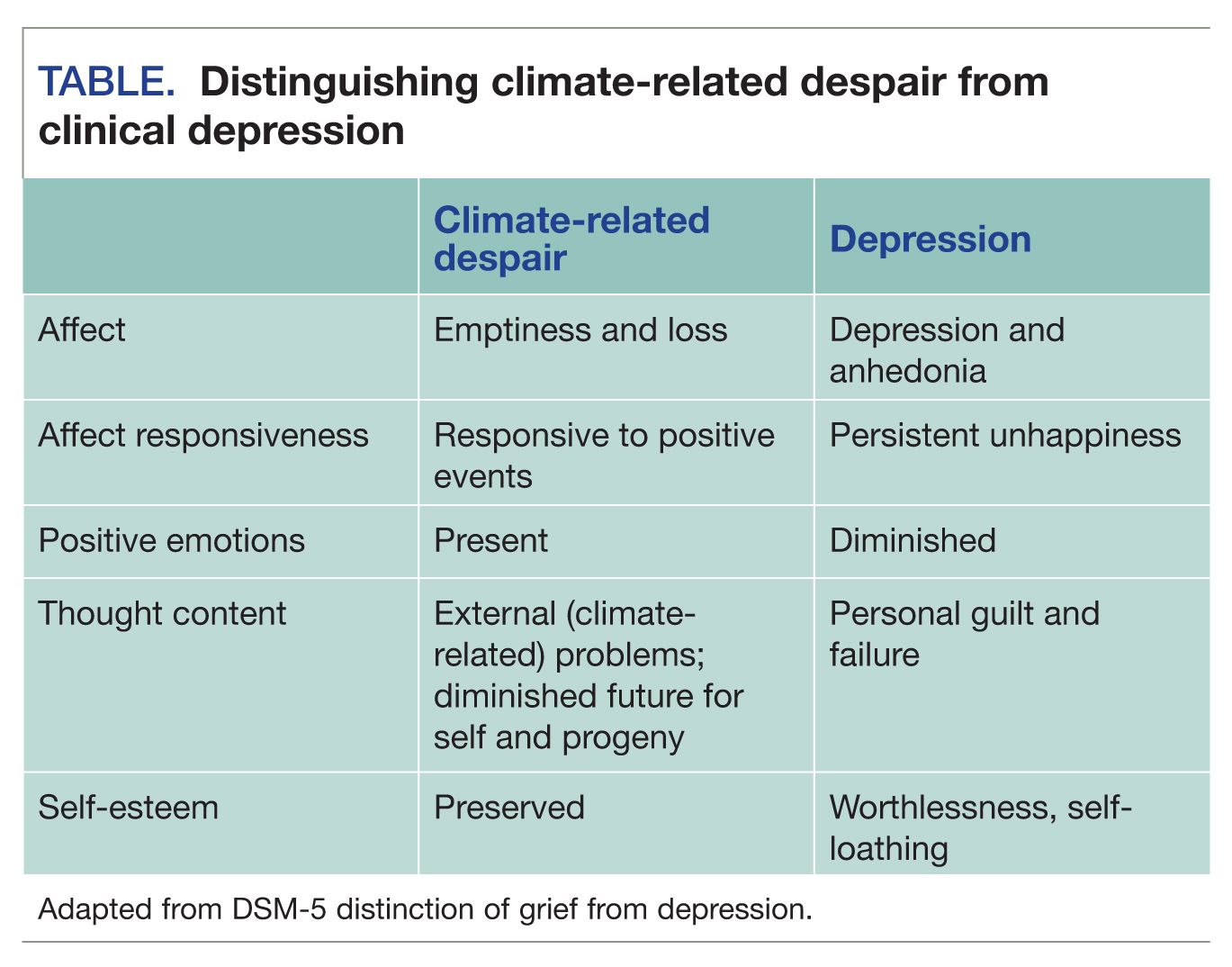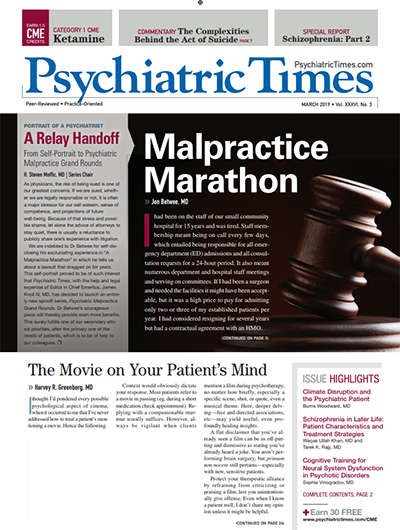Climate Disruption and the Psychiatric Patient
While some psychiatrists may doubt the connection between climate disruption and psychiatric disorders, the evidence is growing stronger every day.
Brais Seara@stock.adobe.com

Exclusive CLIMATE CHANGE coverage
Storms, floods, and fires caused by human-generated global warming correlate with elevated rates of anxiety, depression, and suicide.1 In the longer term, stress- and loss-related psychiatric disorders result from climate-related physical illness, economic disruption, migration, and violence. Limited coping skills and reduced socioeconomic resources make psychiatric patients especially vulnerable to these effects. In day-to-day practice, however, it can be difficult to connect these large-scale events with the treatment of individual patients. Identifying patients at risk for the psychiatric effects of climate disruption provides guidance to clinicians as they address these issues in treatment.
Differences in exposure and coping
The impact of climate disruption on a patient’s treatment is determined by the individual’s exposure to climate-related problems, psychiatric symptoms, resources, coping skills, and readiness to address the risks he or she faces.
TABLE. Distinguishing climate-related despair from clinical depression

Patients who experience distressing or disabling anxiety, depressive rumination, or delusions about climate disruption have diagnosable psychiatric disorders. Such patients need treatment with psychotherapy and/or medication. But some patients with such symptoms also face actual dangers, and treatment is likely to be more effective when the risks they face are considered. Cognitive therapy can distinguish realistic dangers from the catastrophic thinking associated with pathological anxiety and depression. Behavioral interventions to curb internet searches, calls to public officials, and hounding of family members about energy usage can limit symptom aggravation.
Symptom management alone, however, can be maladaptive when there is actual danger. A patient with obsessive-compulsive disorder may need to limit exposure to climate- related news and manage his anxiety about CO2 emissions enough to keep his home warm. But acknowledging his children’s vulnerability to wildfire-associated respiratory illness might motivate him to participate in an advocacy group where social feedback could channel his anxieties toward meaningful steps to reduce his family’s risk.
Patients who have experienced heat waves, wildfires, floods, or other climate-related emergencies may, as the first priority, need guidance about dangers they continue to face. The US Centers for Disease Control and Prevention (CDC) provides information about reducing harm from heat, smoke, and water pollution.2-4 Patients with severe and persistent psychiatric illness are especially vulnerable to these risks because of poor self-care, medical conditions, and medication.
After such disasters, psychiatrists are also likely to see patients suffering from trauma-related disorders and depression as well as exacerbations of pre-existing mental and addictive disorders. After the acute trauma is addressed, clarifying the connection between the patient’s symptoms and weather-related events can lay the groundwork for anticipating and preparing for the next emergency. Moving from viewing the disaster as an unpredictable act of God, for example, to an expected consequence of global warming may free the patient to plan for future disruptions of access to food, water, medication, and treatment, as well as the possible need to evacuate. This can be a step on the path from helpless vulnerability to self-efficacy.
Those living or working in areas at risk for climate-related disasters also benefit from emergency planning, but clinicians may first need to address their patients’ apathy. This appears in many forms-outright denial of risk, belief one is invulnerable, projection of responsibility onto government officials or corporations, exaggerating the efficacy of ameliorative measures, “traditionalist” refusal to change, focusing on immediate problems, or fatalistic passivity.5 When these resistances are addressed, patients will be more able to face the tragedy of their situations.
No region is free from risk-residents of non-coastal New England, for example, may feel complacent in their low vulnerability to wildfires and storm surges but ignore dangers from heat waves, inland flooding, and vector-borne diseases.6 Patients may be open to discussing these risks during periods of severe local weather or news of climate-related events elsewhere.
Warning about danger, however, can be counterproductive when it elicits defensiveness, guilt, or anger.5 In the words of the climate scientist Susanne Moser:
People need a minimum amount of information, a realistic assessment of the threat or diagnosis, a sense of personal control over their circumstances, a clear goal, a clear understanding of the strategies to reach that goal (including the possible setbacks along the way), a sense of support, and frequent feedback that allows them to see that they are moving in the right direction.5p73
This is clearly more than can be accomplished in a single interview; clinicians may need to view their work as a series of steps to help patients change. Motivational interviewing techniques-open-ended questions, reflective listening, summarizing statements, and supportive comments-facilitate collaborative evaluation of risk and planning for safety.
Some patients experience deeper anxieties related to loss of an expected future for themselves, their progeny, or the human species. Others grieve for familiar natural environments or for nature in its sense of an ultimate home.7 Especially vulnerable are those who have devoted personal or career resources to fighting climate change. Such “climate activists” may become despondent with news of further climate degradation or political events that threaten the environment. While some such patients are depressed, others are better characterized as suffering from a form of existential despair. A related issue is psychic numbing. This differs from the apathy associated with failure to understand climate disruption. Numbing occurs when the individual perceives the threat but feels powerless and gives up.
While symptoms of climate-related despair overlap with those of depression, the distinction is worth making, since treatment may differ. DSM-5 provides some guidance in a footnote about the differences between grief and depression.8p126 Extrapolating from this to climate-related dysphoria generates several distinguishing features, which are summarized in the Table.
Affect in climate-related despair comprises feelings of emptiness, loss, and meaninglessness, while clinically depressed patients are depressed and anhedonic. Climate- related despair may be limited in scope: patients may still experience humor and joy about other subjects. Depression, on the other hand, tends to be persistent and pervasive. Individuals suffering from climate-related despair are preoccupied with climate issues and ideas of a diminished future, while in depression thoughts tend toward guilt and hopelessness about one’s own life. Self-critical thoughts in climate-related despair usually involve failure to achieve climate-related goals (eg, passing a carbon tax bill). Self-esteem is generally preserved in climate-related despair, while depressed patients experience self-loathing and worthlessness.
There is no research to support pharmacological treatment of climate-related despair. When clinical depression is present, antidepressants are likely to be useful, since they can be effective for depression in other situations of danger and loss, such as palliative care.
We have no treatment manuals or clinical trials to guide psychotherapy of climate-related despair, but a growing body of evidence supports meaning-based psychotherapy in other tragic situations.9 Such therapies typically combine various techniques, including mindfulness and cognitive-behavioral therapy, to help patients accept difficult situations and unpleasant emotions and to engage in activities that promote their personal values. One such approach, Transformational Resilience, addresses the psychosocial effects of climate disruption at both individual and community levels.10
The challenges for therapists include hearing, containing, and working through patients’ despondency while monitoring for depression, which might require additional treatment. The goal is to convert such despair to what has been called tragic, or active, hope-a positive orientation toward the future despite ongoing recognition of danger and loss.
A key element in such psychotherapy may be the clinician’s role in containing the patient’s dysphoria, anxiety, and trauma symptoms during the search for a path toward meaning and hope. Moving beyond grief to behavior that furthers personal values is likely to promote healing. Some patients may progress from acknowledging danger and loss directly to action without explicit grieving, but therapists are wise to keep in mind their possible need to express unacknowledged dysphoria. Some patients may benefit further when they go beyond individual energy conservation and personal risk reduction to engage with others-by discussing climate issues, participating in community groups, advocating for governmental action, and supporting businesses and organizations that take constructive measures.
Clinicians’ reluctance
Psychiatrists may doubt the connection between climate disruption and psychiatric disorders. The evidence is increasingly strong, and Hayes and colleagues1 have recently published an excellent critical review that is free on PubMed.
Others may view climate-related mental health issues as beyond the scope of psychiatric practice. Making climate disruption the focus of every patient’s treatment would be highly inappropriate, but for many patients, addressing these issues is likely to save lives and improve treatment responses.
Climate disruption is now so politicized that clinicians may fear they will be viewed as advocates or offend patients. While political campaigning in the psychiatric office is inappropriate, effective treatment includes addressing public issues that impact patients’ treatment in clinical terms that emerge from patients’ needs and goals. We address controversial topics such as gun ownership as they relate to patients’ mental health, and we can do the same for climate-related issues.
Psychiatrists may need to address their own fears and despair about climate disruption. Such emotions can lead to avoiding discussion of climate-related issues or approaching the subject in ways that elicit fear or guilt. Recognizing that climate disruption is already occurring, future problems are inevitable, and the problem is global, psychiatrists may believe their own and their patients’ efforts are insignificant. In the end, however, climate problems will be addressed by individual human beings becoming educated and making decisions to act within their areas of influence-at the individual, community, corporate, governmental, and global levels. Addressing climate issues as they affect psychiatric patients advances global change, one patient at a time.
Conclusion
Like other citizens, psychiatrists can educate themselves about climate problems and reduce their carbon footprints. They can prepare their practices for climate-related events by arranging secure and accessible storage of records and making plans for communication with patients during emergencies. They can advocate for similar actions by hospitals, mental health agencies, and professional organizations. They can participate in APA District Branch disaster preparedness committees, the APA Caucus on Mental Health and Climate Change, and the Climate Psychiatry Alliance.
Discussing relevant aspects of climate disruption with individual patients can reduce their exposure to harm. In some cases, it will improve treatment responses. Addressing the paralysis associated with climate- related despair can increase both clinicians’ and patients’ sense of agency in dealing with problems they perceive as out of their control. I have a mental checklist I review annually with each of my patients, which includes screening for tardive dyskinesia, laboratory monitoring for medication adverse effects, smoking status, firearm safety, and contraception. Climate disruption is now on that list.
Disclosures:
Dr Woodward is a psychiatrist in private practice in Waban, MA. Dr Woodward reports no conflicts of interest concerning the subject matter of this article.
References:
1. Hayes K, Blashki G, Wiseman J, et al. Climate change and mental health: risks, impacts and priority actions. Int J Ment Health Syst. 2018;12:28-39.
2. Centers for Disease Control and Prevention. Tips for preventing heat-related illness: https://www.cdc.gov/disasters/extremeheat/heattips.html. Accessed February 11, 2019.
3. Centers for Disease Control and Prevention. Protect yourself from wildfire smoke: https://www.cdc.gov/features/wildfires/index.html. Accessed February 11, 2019.
4. Centers for Disease Control and Prevention. Flood safety tips. https://www.cdc.gov/features/flood-safety/index.html. Accessed February 11, 2019.
5. Moser SC. More bad news: the risk of neglecting emotional responses to climate change information. Moser SC, Dilling L, Eds. Creating a Climate for Change: Communicating Climate Change and Facilitating Social Change. New York: Cambridge University Press; 2007: 64-80.
6. United States Environmental Protection Agency. Climate Impacts in the Northeast. https://19january2017snapshot.epa.gov/climate-impacts/climate-impacts-northeast_.html. Accessed February 11, 2018.
7. Pihkala P. Eco-anxiety, tragedy and hope: psychological and spiritual dimensions of climate change. Zygon. 2018;53:545-569.
8. American Psychiatric Association. Diagnostic and Statistical Manual of Mental Disorders, 5th ed. Arlington, VA: American Psychiatric Association; 2013.
9. Vos J, Vitali D. The effects of psychological meaning-centered therapies on quality of life and psychological stress: a metaanalysis. Palliat Support Care. 2018;16:608-632.
10. Doppelt B. Transformational Resilience: How Building Human Resilience to Climate Disruption Can Safeguard Society and Increase Wellbeing. New York: Routledge; 2017.

